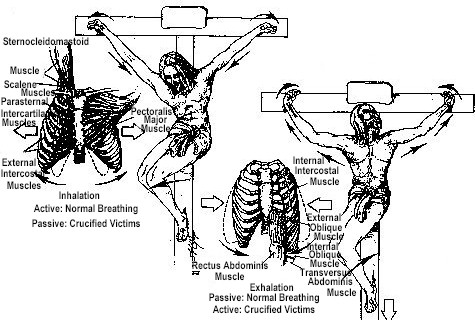 |
|
| Respirations during crucifixion, Left, Inhalation. With elbows extended and shoulders abducted, respiratory muscles of inhalation are passively stretched and thorax is expanded. Right, Exhalation. With elbows flexed and shoulders abducted and with weight of body on nailed feet, exhalation is accomplished as active, rather than passive, process. Breaking legs below knees would place burden of exhalation on shoulder and arm muscles alone and soon would result in exhaustion asphyxia. | |
Most commonly, the feet were fixed to the
front of the stipes by means of an iron spike
driven through the first or second
intermetatarsal space, just distal to the
tarsometatarssal joint. (2,5,8,11,30) It is
likely that the deep peroneal nerve and branches
of the medial and lateral plantar nerves would
have been injured by the nails. Although
scourging may have resulted in considerable blood
loss, crucifixion per se was a relatively
bloodless procedure, since no major arteries,
other than perhaps the deep plantar arch, pass
through the favored anatomic sites of
transfixion. (2,10,11)
The major pathophysiologic effect of
crucifixion, beyond the excruciating pain, was a
marked interference with normal respiration,
particularly exhalation. The weight of the body,
pulling down on the outstretched arms and
shoulders, would tend to fix the intercostal
muscles in an inhalation state and thereby hinder
passive exhalation. (2,10,11) Accordingly,
exhalation was primarily diaphragmatic, and
breathing was shallow. It is likely that this
form of respiration would not suffice and that
hypercarbia would soon result. The onset of
muscle cramps or tetanic contractions, due to
fatigue and hypercarbia, would hinder respiration
even further. (11) Adequate exhalation required lifting the body
by pushing up on the feet and by flexing the
elbows and adducting the shoulders. (2) However,
this maneuver would place the entire weight of
the body on the tarsals and would produce searing
pain. (7) Furthermore, flexion of the elbows
would cause rotation of the wrists about the iron
nails and cause fiery pain along the damaged
median
|
nerves. (7) Lifting of the body would also
painfully scrape the scourged back against the
rough wooden stipes. (2,7) Muscle cramps and
paresthesias of the outstretched and uplifted
arms would add to the discomfort. (7) As a
result, each respiratory effort would become
agonizing and tiring and lead eventually to
asphyxia. (2,3,7,10)
The actual cause of death by crucifixion was multifactorial and varied somewhat with each case, but the two most prominent causes probably were hypovolemic shock and exhaustion asphyxia. (2,3,7,10) Other possible contributing factors included dehydration, (7,16) stress-induced arrhythmias, (3) and congestive heart failure with the rapid accumulation of pericardial and perhaps pleural effusions. (2,7,11) Crucifracture (breaking the legs below the knees), if performed, led to an asphyxic death within minutes. (11) Death by crucifixion was, in every sense of the word, excruciating (Latin, excruciatus, or "out of the cross"). Crucifixion of Jesus After the scourging and the mocking, at about 9 AM, the Roman soldiers put Jesus' clothes back on him and then led him and two thieves to be crucified. (1) Jesus apparently was so weakened by the severe flogging that he could not carry the patibulum from the Praetorium to the site of the crucifixion one third of a mile (600 to 650 m) away (1,3,5,7) Simon of Cyrene was summoned to carry Christ's cross, and the processional then made its way to Golgotha (or Calvary), an established crucifixion site. |
| Back | Next |